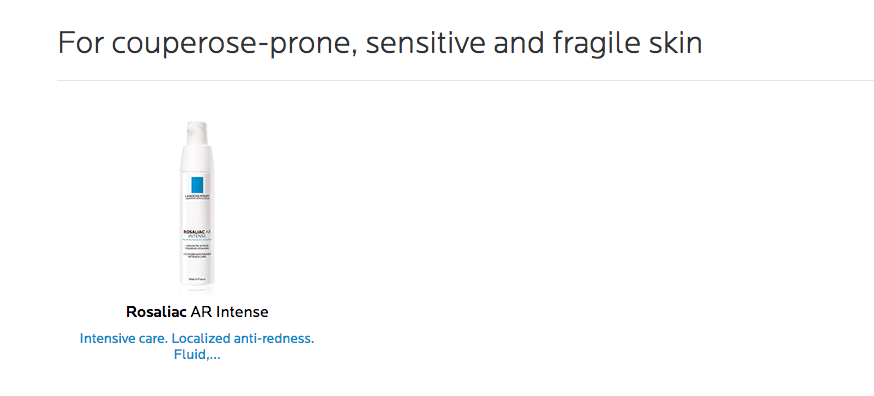Ugh. I just learned I have ROSACEA. The dreaded redness and red spots that come out of nowhere. I thought I was just having some rosy-cheek action, but no. It’s the R word. I immediately reached out to some of my skincare idols to see what they had to deal with this beast. I decided to go forth with La Roche Posay’s ROSALIAC LINE.
ROSALIAC AR INTENSE
Intensive care. Localized anti-redness. Fluid, ultra-fresh and non-oily gel. Non-comedogenic. Hypoallergenic.

Why? Because of this:
For couperose-prone, sensitive and fragile skin & Intense redness. An intensive concentrate that combines 3 active ingredients to reduce redness at source and prevent its reappearance.
Ambophenol INNOVATION: a powerful vegetal extract rich in polyphenols to reduce the size of blood vessels and strengthen their walls.
Neurosensine, a soothing active ingredient to reduce appearance of redness.
Anti-irritant and decongestant La Roche-Posay Thermal Spring Water.
New generation hermetic packaging for an ultra-purified formula. Preservative-free, paraben-free, alcohol-free, fragrance-free, colorant-free.

I will top this with sun block and see how it goes the next few weeks. I hear this is an incredible combo to combat rosacea. Stay tuned!

Visible vessels on the face are called rosacea. A common condition, it is often accompanied by erythrosis, diffuse redness on the cheeks. Some skin types go red easily due to stress, heat, cold and even digestion. How can it be cured? Advice from a dermatologist.
What is the profile of patients with rosacea?
The presence of dilated vessels on the face is evidence of the fragility of the skin’s capillaries.
It is more common in patients with pale and thin skin. Certain factors are conducive to the appearance of rosacea. A sudden change from cold to hot, cigarette smoke, spices, alcohol and stress. These all easily cause dilation of the blood vessels on the face. Beware of the myths linked to this condition, however: having rosacea does not mean that you drink too much!
What advice do you give your patients?
We must of course take action on these factors conducive to rosacea.
When a patient has pale skin, he should avoid eating spicy foods and protect himself from the cold with very moisturising cosmetics in winter. It is a good reason to stop smoking. I always recommend the use of cosmetic creams containing active ingredients that act on the skin’s microcirculation. It is also important to remove make-up gently to avoid irritating the skin. Finally, I encourage the use of suitable corrective make-up
What are the treatment solutions?
When there are just a few highly visible vessels, electrocoagulation is still an option.
Nowadays, vascular lasers give excellent results. The KTP laser can greatly improve rosacea in 2 sessions spaced 6 weeks apart. I also use Intense Pulsed Light (flash lamp) which gives good results on erythrorosacea. These treatments must be carried out at times when the skin is not exposed to the sun.
